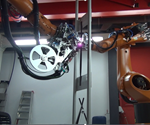Hexcel applies additive manufacturing to unmanned aerial vehicle systems
Hexcel’s HexAM process produces stiff, lightweight and complex components that are often too expensive or impossible to produce.

Pictured is a transition duct for an unmanned aerial vehicle (UAV) made by GA-ASI using Hexcel HexAM additive manufacturing technology. Source | GA-ASI
Hexcel Corp. (Stamford, Conn., U.S.) reported that it has been a key partner with General Atomics Aeronautical Systems (GA-ASI, San Diego, Calif., U.S.) in the development and production of carbon fiber-reinforced thermoplastic components for complex structures on GA-ASI’s unmanned aerial vehicle (UAV)/remotely piloted aircraft (RPA) systems.
“The HexAM process produces stiff and lightweight components that are critical for aerospace systems,” says Larry Varholak, vice president of Additive Manufacturing at Hexcel. “We value our collaboration and work with GA-ASI to develop the components for its UAV/RPA systems that enhance performance while lowering costs.”
Using HexAM technology, Hexcel and GA-ASI are said to have produced several complex geometric components that would otherwise be expensive or impossible to produce with traditional composite, molding, or machining methods. Many of the applications, Hexcel says, are for inner mold line (IML), outer mold line (OML), ducting and manifolds where the complex geometries enabled by additive manufacturing provide design freedom and an easier manufacturing process to improve performance and operation of UAV systems.
Hexcel says in addition to carbon fiber-reinforced polyetherketoneketone (PEKK) which has mechanical and thermal properties that are ideal for UAV/RPA systems, it has also developed bonding methods for larger structures that broaden the component application space that GA-ASI can take advantage of.
“The Hexcel team has helped us enhance our additive manufacturing applications space,” points out Elie Yehezkel, senior vice president of Advanced Manufacturing Technologies at GA-ASI. “We are finding HexAM technology and the additive manufacturing process at Hexcel to have a solid foundation of material data that we can use for design and analysis.”
Yehezkel also notes that through GA-ASI’s engagement with the Hexcel team, the latter have demonstrated their process to be robust, repeatable and capable of producing complex parts and assemblies needed for GA-ASI’s systems. Despite the carbon-filled PEKK HexAM process being thermally challenging, Yehezkel says Hexcel seems knowledgeable at delivering components that can repeatedly meet the company’s dimensional tolerance requirements.
The partnership, Hexcel says, continues to propel new applications for HexAM technology. Grounded with a solid foundation of material properties testing, the teams are now able to move quickly from prototyping to production for new applications for the technology on GA-ASI systems.
Related Content
-
Tool Gauge, Victrex partner to develop co-molded composite aircraft parts
Novel hybrid overmolding technology achieves novel thermoplastic composite parts to replace machined aluminum components on commercial aircraft, as well as reduce manufacturing costs and timeline.
-
In oil and gas, an additive manufacturing standard (API 20T) will aid adoption of composites
Polymer AM equipment maker Roboze sees how the oil and gas industry’s way forward with additive is like that of another high-stakes industry, aerospace, and also different in important aspects.
-
Queen’s University Belfast presents research in thermoplastic drilling performance optimization
Researchers have published findings from a multi-objective optimization study on carbon fiber-reinforced PEKK drilling in an effort to better understand the material for use in aviation fastenings.














